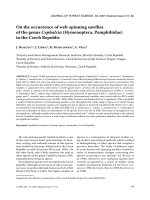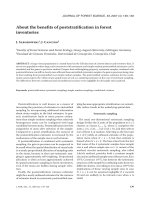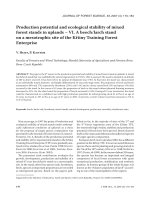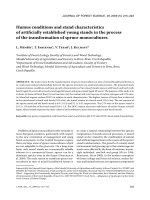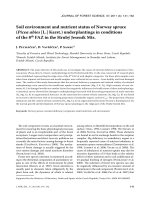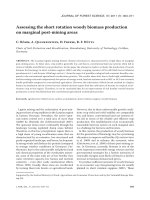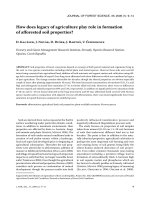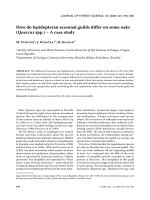Báo cáo lâm nghiệp: "How the absolute growth rate of poplar adapts to the light-NO -dosage 3 G.A. Pieter" pot
Bạn đang xem bản rút gọn của tài liệu. Xem và tải ngay bản đầy đủ của tài liệu tại đây (231.73 KB, 7 trang )
How
the
absolute
growth
rate
of
poplar
adapts
to
the
light-NO
-3
-dosage
G.A.
Pieters
Department
of
Plant
Physiological
Research.
Agricultural
University
Gen.
Foulkesweg !
2.
6703
8W
Wageningen,
The
Netherlands
Introduction
The
growth
of
leaves
and
internodes
on a
branch
of
poplar,
grown
under
constant
conditions,
proceeds
according
to
growth
patterns,
which:
1)
can
be
defined
as
organ-specific
relations
between
the
rela-
tive
growth
rate
(RGR)
and
the
age
of
the
organ;
and
2)
are
independent
of
irradi-
ance.
Consequently,
the
absolute
growth
rate
of
such
a
branch
cannot
adapt
to
irra-
diance
via
these
growth
patterns.
A
poplar
plant
adapts
its
absolute
growth
rate
to
high
irradiance
by
a
gradually
faster
pro-
duction
of
proportionally
larger
primordia
at
its
apex.
At
the
same
time,
the
apical
volume
and
the
phyllotactic
order
are
increasing.
It
could
be
shown
that
the
api-
cal
volume
is
proportional
to
the
rate
of
leaf
area
production
(Pieters
and
van
den
Noort,
1988).
Under
optimal
conditions,
the
stem
elongation
rate
increases
propor-
tionally
to
the
leaf
production
rate
and,
on
the
average,
this
results
in
internodes
with
constant
mature
length.
Larson
(1975)
analyzed
the
develop-
ment
of
the
vascular
system
of
poplar.
The
number
and
the
length
of
the
vascular
bundles
in
the
vascular
cylinder
increase
in
a
systematic
way;
at
the
same
time,
phyllotactic
order
increases.
According
to
Larson’s
analyses,
new
procambial
traces
develop
long
before
the
primordia
they
will
serve
are
visible
at
the
apex.
Combining
Larson’s
data
with
ours,
we
established
a
striking
correspondence
be-
tween
the
development
of
the
vascular
system
of
poplar,
the
growth
of
the
organs
and
the
development
of
absolute
growth
rate
of
the
plant.
Adaptation
proceeds
via
enlargement
of
the
primary
vascular
sys-
tem
(Pieters
and
van
den
Noort,
1988).
A
larger
vascular
system
is
reflected
in
a
lar-
ger
apical
volume
and
produces
propor-
tionally
more
and
larger
leaf
primordia,
which
grow
out
to
a
proportionally
larger
final
size.
Whenever
an
equilibrium
is
reached
between
assimilate
production
and
use
in
the
plant,
the
primary
vascular
system
stops
expansion
and
the
branch
grows
linearly
with
time.
Because
the
vascular
system
develops
before
the
primordia,
we
suggest
that
the
growth
of
a
plant
is
a
reflection
of
the
development
ct
the
vascular
system.
Preliminary
experiments
with
sunflower
and
poplar
(Pieters
and
van
den
Noort,
1985)
suggested
that
the
absolute
growth
rate
of
a
branch
adapts
in
a
way
similar
to
that
of
nitrate
dosage.
As
the
availability
of
(reduced)
nitrate
in
the
plant
becomes
limiting,
the
expansion
of
the
vascular
sys-
tem
stops
and
the
branch
grows
linearly
with
time.
The
aim
of
this
article
is
to
report
the
effects
of
photon
fluence
rate
(PFR)
and
nitrate
dosage
on
growth
and
some
chem-
ical
properties
of
a
poplar
branch
during
the
adaptation
to
a
nitrate
dosage
that
is:
1)
linear
with
time,
and
2)
in
proportion
to
irradiance
(cf.
Ingestad,
1987).
Materials
and
Methods
Fresh
cuttings
of
Populus
euramericana
(Dode)
Guinier
cv
Robusta,
on
which
one
branch
was
allowed
to
grow,
were
cultivated
in
growth
rooms
at
22
*
C,
60%
RH
and
a
day
length
of
16
h
on
a
nitrate-free
culture
solution.
Nitrate
was
added
daily
as
a
solution
of
KN0
3,
Ca(N0
3)2
and
Mg(N0
3)2
(molar
ratio:
T_L I-
II
M I_.:
_ a.L
&dquo;&dquo;_1.1.
35:45:20),
according
to
the
scheme
presented
in Table
I.
Six
and
four
plants
were
used,
respectively,
for
the
2
highest
and
the
lowest
nitrate
dosage.
Three
times
per
week,
length
and
thickness,
respectively
diameters
of
leaves
and
internodes
were
measured.
The
other
measurements
were
made
on
harvested
plants.
The
plants
were
harvested
3
times,
and
those
grown
at
0.0
mmol
N0
3
twice.
Chlorophyll
was
determined
according
to
Bruinsma
(1963),
the
chemical
analyses
using
the
methods
described
by
the
Department
of
Soil
Science
and
Plant
Nutrition,
AU,
Wagenin-
gen.
Results
Relative
growth
rate
(RGR)
at
half
mature
length
of
an
organ
(RGR
SO
)
was
nearly
independent
of
the
absolute
N0
3
dosage
or
PFR
(Table
II,
N°3’-codes
1
and
2).
At
a
nitrate
dosage
of
0.0
mmol
’
planr
1
’d-
1
(N0
3
code
3)
the
nitrate
reserve
in
the
cut-
ting
was
rapidly
used
up
and
redistribution
mo1&dquo;ro
1.!Mh
lO/20__1
nf
1.o.&dquo;3B1.o! &dquo;:lInn
of
nitrate
could
not
sustain
a
high
RGR
50
in
growing
leaves.
Dry
matter-
(Fig.
1)
and
N-
(Fig.
2)
distri-
bution
depended
mainly
upon
the
ratio
- -
,
between
PFR
and
nitrate-dosage
(PIN-
quotient).
Also
the
root-shoot
ratio
de-
pended
on
the
PIN-quotient
and
not
on
the
absolute
PFR
or
nitrate
dosage
(see
- -
,
Fig.
1
At
high
irradiance,
the
nitrate
concentration
(Fig.
2)
showed
a
prolonged
adaptation
in
respect
to
that
of
the
plants,
grown
at
low
irradiance,
because
the
plants
continued
to
grow,
while
at
low
irra-
diance
and
limiting
N-dosage
the
N-distri-
bution
was
frozen
by
induced
dormancy
(no
growing
leaves
at
the
last
harvest).
At
the
nitrate
dosage
of
0.0
mmol!
plant-1’day-
1,
plants
grown
at
7.5
W-
M-2
were
dormant
at
the
first
harvest
and
those
grown
at
30
W-m-
2,
were
dormant
at
the
second
harvest.
The
nitrate
defi-
ciency
was
evenly
distributed
over
mature
and
growing
leaves.
Nitrate-reductase
activity
(NR-act,
Fig.
3)
and
leaf
chlorophyll
content
(Fig.
4)
depended
also
mainly
upon
the
P/N-quo-
tient.
As
expected,
NR-act
declined
with
the
(relative)
availability
of
nitrate
and
with
(mean)
age
of
the
(increasing)
group
of
older
mature
leaves.
The
NR-act
of
grow-
ing
leaves
was
generally
lower
than
that
of
young
mature
leaves;
this
difference
be-
came
smaller
with
rising
deficiency.
NR-
act
in
the
roots
was
found
to
be
insignifi-
cant.
As
expected,
chlorophyll
content
de-
clined with
rising
deficiency.
At
high
irradi-
ance,
thicker
leaves
were
formed:
the
measured
leaf
thickness
was
220
pm
in
sun
leaves
and
120
pm
in
shade
leaves.
The
higher
chlorophyll
contents
in
leaves
of
the
30
W!m-2
plants
in
respect
to
7.5
W-
M-2
plants
(Fig.
4)
was
likely
caused
by
this
difference
in
thickness.
Discussion
The
growth
patterns
of
leaves
and
inter-
nodes
are
not
influenced
by
the
absolute
nitrate
dosage
and
irradiance,
as
judged
by
the
development
of
individual
leaves
and
internodes
in
the
linear
phase
of
growth
and
by
ine
constancy
of
relative
growth
rate
at
half
mature
length
(RGR
50).
The
data
presented
in
this
paper,
there-
fore,
suggest
that
a
plant
adapts
its
abso-
lute
growth
rate
to
a
linear
nitrate
dosage,
as
to
PFR,
through
adaptation
of
the
size
of
the
apex,
casu
quo
of
the
vascular
sys-
tem.
The
increase
in
size
of
the
apex
of
plants,
growing
in
optimal
root
environ-
ment,
proceeds
linearly
with
time
with
a
rate
proportional
to
irradiance
(data
not
shown).
As
explained
in
the
Introduction,
a
larger
apex
produces
proportionally
faster
and
larger
primordia,
which
grow
to
matu-
rity
according
to
a
pattern
independent
of
PFR
and
nitrate
dosage.
Presumably,
plant
growth
reacts
similar-
ly
on
a
deficiency
of
p
o3-
(members
of
the
Department
of
Plant
Nutrition,
AU,
per-
sonal
communication).
The
plant
is
not
able
to
adapt
to
a
deficiency
of,
e.g.,
K+
or
Mg
2+
and
reacts
with
immediate
deficien-
cy
symptoms
(Dorenstouter
ef aL,
1985).
Linear
dosage
of
nitrate
in
proportion
to
PFR
revealed
that
for
optimal
growth
with
minimal
deficiency
symptoms,
an
optimal
ratio
exists
between
PFR
and
the
dosage
of
N0
3
and,
presumably
p
o3
Although
we
have
not
yet
analyzed
this
ratio
quanti-
tatively,
we
propose
that
the
constancy
of
this
ratio
points
to
a
morphogenetic
signifi-
cance
of
protein
synthesis
for
the
enlarge-
ment
of
the
vascular
system.
Acknowledgments
The
members
of
the
Department
of
Soil
Sci-
ence
and
Plant
Nutrition,
AU,
Wageningen,
are
duly
acknowledged
for their
help
and
advice.
References
Bruinsma
J.
(1963)
The
quantitative
analysis
of
chlorophylls
a
and
b
in
plant
extracts.
Photo-
chem.
Phytobiol.
2,
241-249
Dorenstouter
H.,
Pieters
G.A.
&
Findenegg
G.R.
(1985)
Distribution
of
magnesium
between
chlorophyll
and
other
photosynthetic
functions
in
magnesium
deficient
’sun-’
and
’shade-’
leaves
of
poplar.
J.
Plant
Nutr.
8, 1089-1101
Ingestad
T.
(1987)
New
concepts
on
soil
fertility
and
plant
nutrition
as
illustrated
by
research
on
forest
trees
and
stands.
Geoderma
40,
237-
252
Larson
P.R.
(1975)
Development
and
organiza-
tion
of
the
primary
vascular
system
in
Populus
dettoides
according
to
phyllotaxy.
Am.
J.
Bot
62, 1084-1099
Pieters
G.A.
&
van
den
Noort
M.E.
(1985)
Leaf
area
coefficient
of
some
Populus
euramericana
strains.
Photosynthetica
19, 189-193
Pieters
G.A.
&
van
den
Noort
M.E.
(1988)
Effect
of
irradiance
and
plant
age
on
the
dimensions
of
the
growing
shoot
of
poplar.
Physiol.
Plant.
74,467-472
